Are Dalmatians Rare? [Shocking Statistics]
Dalmatians, the eye-catching spotted dogs often associated with firefighters and Disney’s 101 Dalmatians, have a unique and interesting history. Originating from the Dalmatian coast in Croatia, these distinct dogs have captured the hearts of many due to their striking appearance and loyal temperament. But are these dogs as rare as one might think?
In recent years, Dalmatians might not be as common a sight as other dog breeds, but they are far from rare. According to the American Kennel Club (AKC) breed ranking, Dalmatians rank around the middle when compared to other breeds.
Despite their distinctive appearance, Dalmatians continue to maintain a strong presence, both as family pets and working dogs in various capacities, such as therapy and search-and-rescue dogs.

Nonetheless, a level of rarity can be found within the breed itself, particularly concerning their genetics. Dalmatians have a unique urinary system compared to other dogs, which results in higher levels of uric acid in their bodies. This distinctive genetic trait is exclusive to the Dalmatian breed.
So while their numbers might not be dwindling, Dalmatians do carry an uncommon genetic aspect that sets them apart from other breeds.
Origin and History of Dalmatians
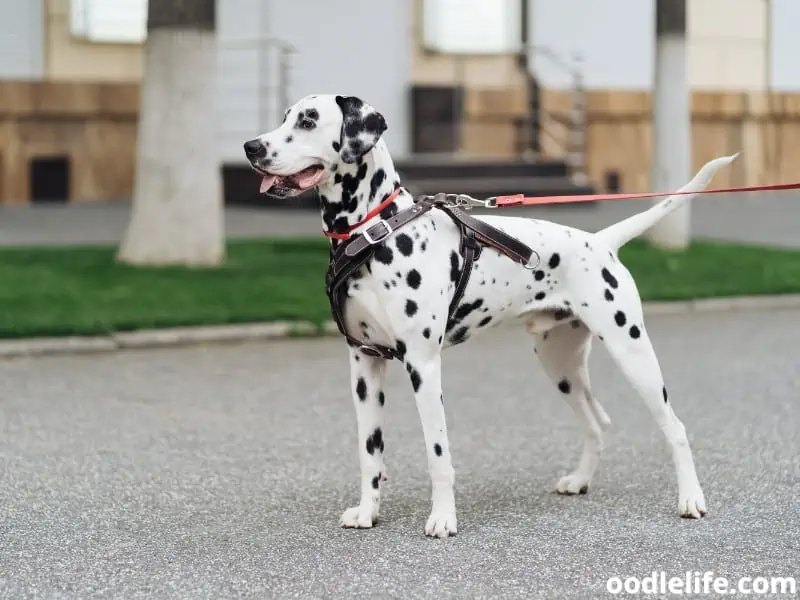
Dalmatia and Croatia
The Dalmatian breed is believed to have originated from the coastal region of Dalmatia in present-day Croatia. Although the exact origins of the breed are unclear, evidence suggests that Dalmatians have a long history in the region, as they were depicted in various Croatian artworks and church chronicles dating back to the 17th century. Their unique spotted coat and striking appearance have made them a distinct and easily recognizable breed.
Fire Dogs and Mascots
In the past, Dalmatians were commonly used as fire dogs, thanks to their strong, agile build and excellent running abilities. They would accompany horse-drawn fire carriages to the scene, clearing the way and protecting the horses from other animals. Their natural affinity for horses made them particularly suited to this role.
Even today, Dalmatians are often considered the unofficial mascot of fire stations and can occasionally be seen at events and parades alongside firefighters.
Circus Performers and Hunting Dogs
Dalmatians have also been popular as circus performers due to their intelligence, sociability, and athletic abilities. They would often be trained to perform tricks and entertain audiences with their energetic demeanor and striking appearance. Additionally, their strong muscles and keen sense of smell made them effective hunting dogs in historical times, used to chase and flush out game as well as protect their owners from potential danger.
In conclusion, the Dalmatian’s rich history is marked by its adaptability and various roles throughout the ages, from its origins in Croatia to its work as fire dogs, mascots, circus performers, and hunting dogs.
Physical Traits and Uniqueness
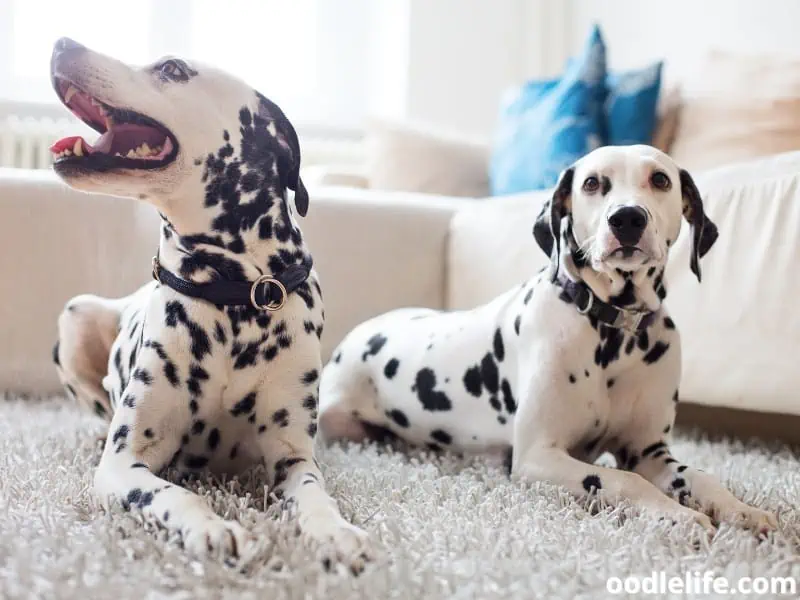
Spotted Coat
The Dalmatian is truly a one-of-a-kind breed, famous for its unique spotted coat. Born with an all-white coat, Dalmatians start developing their well-known black spots within a few weeks. Lemon and orange Dalmatians exhibit a lighter spot color, ranging from pale yellow to a soft or deep orange.
No two Dalmatians feature the exact same spotting pattern, making each individual dog a living work of art.
Eye and Nose Color
Dalmatians can also have unique eye colors. Most have brown or amber eyes, but it is not uncommon for one or both eyes to be blue. It’s essential to note that blue-eyed Dalmatians may sometimes be more prone to deafness.
The nose color of a Dalmatian typically coordinates with the color of their spots. Black-spotted Dalmatians usually have a black nose, while lemon or orange-spotted Dalmatians have brown noses. This harmony between the spots and nose color adds to their overall distinctive appearance.
In conclusion, Dalmatians are celebrated not only for their rare and striking spotted coats but also for their exceptional eye and nose colors. These remarkable traits ensure that each Dalmatian stands out as a perfect example of their eye-catching breed.
Temperament and Personality
Dalmatians are famous for their distinct black or liver-colored spots on a white coat. These eye-catching dogs are not just beautiful; they also possess unique traits that make them stand out in terms of temperament and personality.
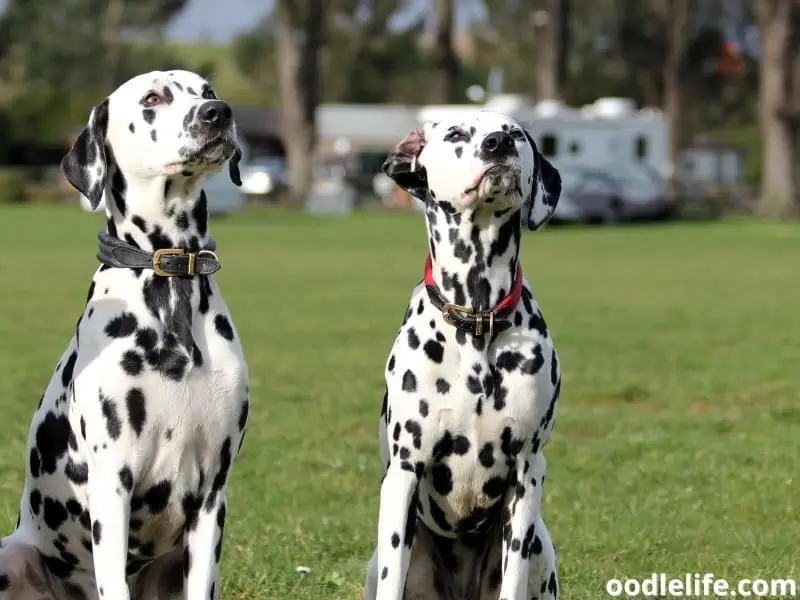
Guard Dogs
Dalmatians have a history of being used as guard dogs, thanks to their natural protective instincts. They are alert and watchful, which makes them excellent at keeping an eye on their surroundings. However, it’s important to remember that each dog has its unique traits, so not all Dalmatians will fit the mold of a perfect guard dog.
Loyalty and Affection
These spotted canines are known for their loyalty and affection towards their human families. They love being around people and generally enjoy receiving attention. A well-socialized Dalmatian can definitely be a loving family companion.
Just be sure to shower them with love and cuddles so they can reciprocate their affection in the best way possible!
Energy and Exercise
Dalmatians are energetic dogs that need regular exercise to stay healthy and happy. A brisk walk or an active play session in the outdoors will help burn off their exuberant energy. These dogs are well-suited for families with an active lifestyle – as they say, a tired Dalmatian is a good Dalmatian!
So, while Dalmatians may not be a rare breed, their combination of distinct appearance, protective nature, loyalty, and energy make them a unique choice for dog lovers. Just remember that every spotted friend has its personality, so get to know your Dalmatian on a personal level – they just might surprise you!
Popularity and Rarity

Disney’s Influence
It’s not hard to see why Dalmatians became more popular after Disney’s classic film, “101 Dalmatians,” was released. The movie showcased the breed’s unique spots and friendly demeanor, captivating audiences worldwide. Although this surge in interest led to an increase in Dalmatian ownership, the breed’s popularity was, for the most part, short-lived.
As a result, several generations later, Dalmatians aren’t as commonly seen as they once were during the height of their “Disney fame.”
Comparison to Other Breeds
While Dalmatians may not be considered one of the rarest dog breeds, their popularity continues to fall well below breeds like Golden Retrievers and Labrador Retrievers. These breeds are often considered more family-friendly, with consistently higher popularity rankings. To put things in perspective, the American Kennel Club currently ranks Dalmatians as the 56th most popular dog breed out of 197 recognized breeds.
In contrast, the consistently popular Labrador Retriever holds the top spot on the list.
However, relative to the rarest dog breeds, such as the Otterhound or the Finnish Spitz, Dalmatians are still quite popular. Their unique spots and distinctive appearance continue to win over potential dog owners who seek a companion that stands out from the crowd.
In conclusion, while Dalmatians have experienced fluctuations in popularity partially due to Disney’s influence, they remain a breed that is neither extremely popular nor extraordinarily rare. Their enduring appeal stems from their unique appearance and friendly nature, making them a recognizable and cherished breed by dog enthusiasts worldwide.
Health Issues and Concerns

Deafness and Blindness
Dalmatians, like many other dog breeds, can suffer from hereditary health issues. One common concern is deafness. A significant number of Dalmatians are born with a genetic predisposition to hearing loss, which could be bilateral (both ears) or unilateral (one ear) deafness.
Breeders are encouraged to screen their dogs for this issue to minimize the chances of producing deaf offspring.
Another vision-related concern that affects Dalmatians is progressive retinal atrophy (PRA). This is a genetically inherited disease that causes the slow degeneration of the retina, ultimately leading to blindness. Luckily, responsible breeders can test for the presence of this gene before breeding, helping to minimize the occurrence of PRA in the Dalmatian population.
Stones
Another noteworthy health issue affecting Dalmatians is the predisposition to form urinary stones. Dalmatians have a unique metabolic trait that causes them to produce high levels of uric acid, making them prone to developing urinary stones. To manage this condition, owners need to pay close attention to their dog’s diet and hydration, avoiding foods with excessive purine content and providing ample water.
Allergies
Dalmatians, like many other dog breeds, can also suffer from various allergies. Skin allergies can be provoked by environmental factors like pollen, dust mites, or even specific foods. The best way to determine the cause of an allergy is through an elimination process, either by adjusting the dog’s diet or minimizing exposure to potential allergens.
Regular grooming can also help keep allergens at bay.
In conclusion, while Dalmatians are a beautiful and intelligent breed, they do come with their fair share of health issues and concerns. By being mindful of these conditions and working with responsible breeders, owners can take preventive measures to ensure their furry companions live a happy, healthy life.
Training and Socialization
Training and socialization are vital aspects of raising a Dalmatian, as these factors contribute to the dog’s overall behavior and temperament. This section will focus on early training, positive reinforcement, and mental stimulation to ensure a well-rounded and well-behaved Dalmatian.
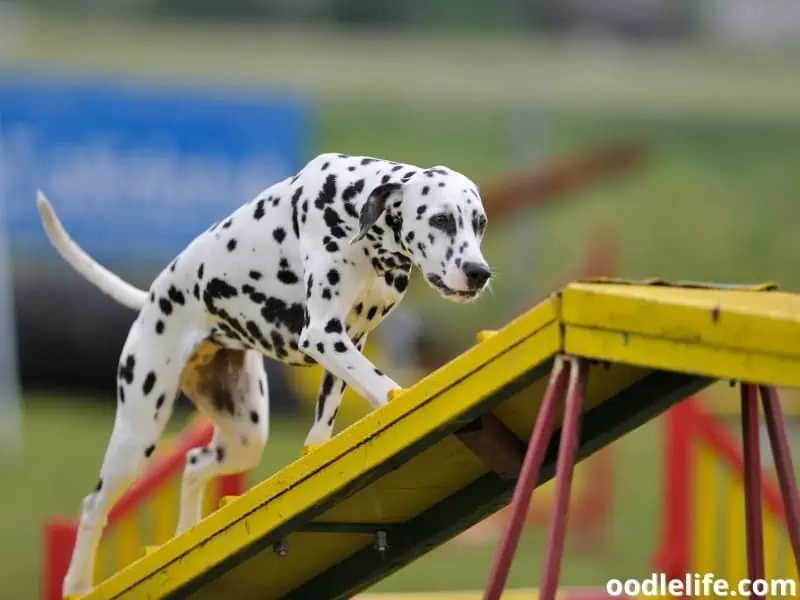
Early Training
Early training is essential in shaping Dalmatian behavior. It is important to begin socializing Dalmatians with other people, pets, and environments from a young age. For example, exposing them to various situations, such as car rides, new surfaces, and even the sound of vacuum cleaners, will help them adapt and become more comfortable in their surroundings.
This reduces the likelihood of developing aggression or anxiety and promotes a confident, well-behaved dog.
Positive Reinforcement
Utilizing positive reinforcement in Dalmatian training is key to promoting good behavior. This method involves rewarding the dog with treats, praise, or even playtime when it demonstrates a desired behavior. For instance, if your Dalmatian sits on command, offer a treat or toy as a reward.
Avoid punishing or scolding the dog, as this can cause confusion and ultimately hinder the training process. With consistency and patience, positive reinforcement can effectively teach Dalmatians to be obedient and well-mannered companions.
Mental Stimulation
Dalmatians are intelligent and energetic dogs, so it’s crucial to provide mental stimulation in their daily lives. Mental stimulation can be achieved through various activities such as puzzle toys, interactive games, and training exercises. These activities will challenge the dog’s brain, keep them engaged, and help prevent boredom-related issues, such as destructive behavior or excessive barking.
When interacting with children, it’s important for both parties to be supervised, as excited Dalmatians might accidentally knock over a child. Additionally, teaching children how to properly interact with the dog will encourage a healthy, respectful relationship between them.
In conclusion, proper training, socialization, and mental stimulation play significant roles in raising a well-rounded Dalmatian. These elements not only improve the dog’s behavior but also contribute to a harmonious relationship between the Dalmatian, its family, and other pets.
Adopting a Dalmatian

Finding a Reputable Breeder
When considering adopting a Dalmatian, it’s crucial to find a reputable breeder. The American Kennel Club (AKC) is a trustworthy source for authorized breeders. Doing research before you adopt a Dalmatian puppy can save you from potential health problems and ensure that you’ll get a dog with a good temperament.
After all, you want a companion that can keep up with your love for spotted masterpieces and firehouses.
A reputable breeder will provide documentation for the dog’s pedigree and adhere to the best practices for Dalmatian breeding. When visiting potential breeders, keep an eye out for healthy, well-socialized puppies, and don’t be afraid to ask questions. Remember, you’re basically playing detective; are those spots real or just a clever disguise?
You decide!
Adoption Process
Adopting a Dalmatian isn’t a sprint, but it’s well worth the marathon. The process usually involves filling out an application to ensure you’re a suitable pet parent. Breeders and rescue organizations will assess your living situation, experience with dogs, and understanding of the Dalmatian’s personality to determine if you’re a good match.
Don’t be surprised if you feel like you’re being cross-examined—it’s just their way of ensuring these energetic pups will be well cared for and won’t end up trying to join the fire department in their spare time.
Considerations
Before committing to adopt a Dalmatian, make sure you’re aware of the breed’s unique personality traits and potential health problems. Dalmatians are spirited and intelligent dogs but can be headstrong and stubborn at times. They require regular exercise and mental stimulation to prevent boredom and destructive behavior.
Think of them as the feisty protagonists of their own spots-filled adventure, always eager for the next challenge.
As for health, Dalmatians are prone to certain issues, such as deafness and urinary stones. Scheduling regular checkups with a vet is essential for preventing and detecting these conditions early. When you become a Dalmatian parent, you’ll not only be responsible for the critter’s spotted adventures but also its health and overall well-being.
In conclusion, adopting a Dalmatian requires careful research and a strong commitment to the breed’s unique needs. Finding a reputable breeder, understanding the adoption process, and considering the dog’s health are crucial steps to ensure a successful Dalmatian adoption. And who knows, perhaps one day you’ll have your own army of polka-dotted heroes to call your family.
Dalmatians in a Family Setting
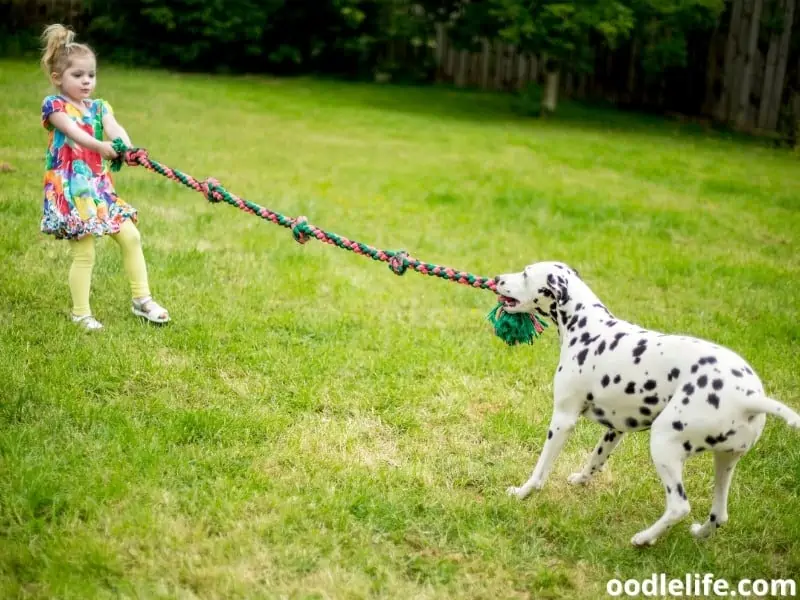
Compatibility with Kids
Dalmatians are often seen as great family pets due to their high energy levels and friendly nature. They typically get along well with kids and enjoy playing with them, making them a popular choice for families with small children. For example, a Dalmatian might have a blast playing fetch in the backyard with the kids or being a loyal companion on family walks.
However, it’s essential to keep in mind that, like any breed, some Dalmatians may have a more difficult temperament, so it’s crucial to properly socialize them from a young age to ensure they are gentle and well-behaved around kids.
Apartment Living
In general, a Dalmatian’s high energy levels make them better suited for homes with ample outdoor space, like a yard or access to a dog park. They may not be the ideal choice for living in an apartment, as their exercise needs can be challenging to meet in limited space. Dalmatians require daily physical activity and mental stimulation to avoid developing behavioral problems.
For instance, regular trips to the dog park, walks, and interactive play sessions can help these spotted pups stay happy and healthy in an urban environment.
Outdoor Space
Dalmatians thrive in environments where they have plenty of room to run and play. Their naturally energetic disposition means they love to spend time outdoors, whether it’s a game of fetch or a long walk with their human companionship. This is why families with a backyard or easy access to outdoor spaces like parks make great homes for these playful canines.
Having a dedicated space for your Dalmatian to stretch their legs and burn off energy will significantly contribute to their overall well-being and happiness in a family setting. Remember, a happy Dalmatian is a well-exercised Dalmatian!
Cost and Demand of Dalmatians
Dalmatians are a unique and eye-catching breed, leading to a certain level of demand in the dog market. However, they are not considered extremely rare. The cost of a Dalmatian puppy can vary depending on factors such as the breeder’s reputation, the puppy’s lineage, and location.

On average, you can expect to pay between $800 and $1,200 for a Dalmatian puppy from a reputable breeder.
High-quality breeders make a difference in the long-term health and behavior of your pup. When searching for a Dalmatian, it’s wise to go for reputable breeders who perform health checks, follow ethical breeding practices, and provide support throughout the puppy’s life. This might make the initial cost higher than buying from less orderly sources, but it is a more rewarding experience and can save you from potential medical expenses down the line.
Dalmatians are known for their unique and adorable spots, but what some people might not know is that they’re highly energetic and intelligent dogs. Their high demand is a testament to their beautiful appearance and engaging personalities. As potential Dalmatian owners, it’s essential to understand that this breed requires regular exercise, mental stimulation, and consistent training.
So, before diving into Dalmatian ownership, make sure you’re prepared for everything that comes with such a spotty and lively companion.
While the cost and demand for Dalmatians may be slightly higher than some other breeds, one thing is certain: owning a thoroughly bred and well-trained Dalmatian can be a rewarding and happy experience. Just be sure to do your research, invest in the best breeder you can find, and remember to offer them plenty of love, cuddles, and spots of your own!